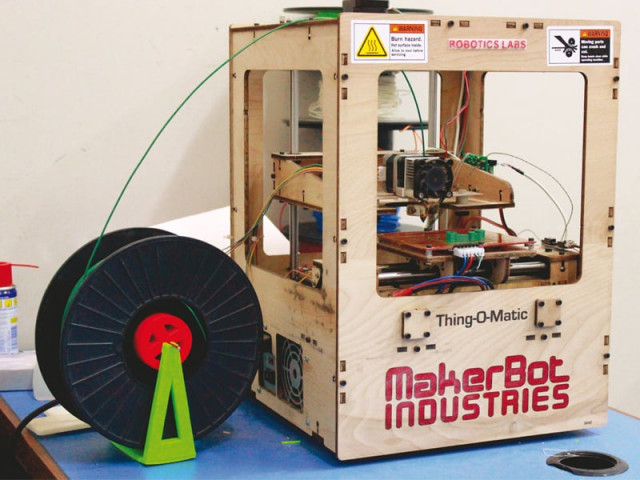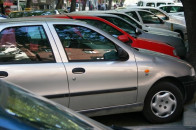3D: The future is printed
A step into the three-dimensional universe that is all set to transform the future.

A step into the three-dimensional universe that is all set to transform the future. PHOTOS: PIR AKRAM SUHARWARDY
The concept of 3D printing was born in 1984 when visionary Charles W Hull invented stereolithography — a printing process that creates a 3D object using digital data. Visually, a stereolithograph is like the fine lines a chef makes on a piece of fish for sushi. Similarly, 3D printing is a layer-by-layer manufacturing process, called additive manufacturing, in which the printer melts plastic or metal under a certain temperature to produce 3D objects of any shape. The 3D printer doesn’t waste any raw material which makes it cost-effective and environment friendly, unlike the traditional machining techniques. While plastic and metal are the most commonly used raw materials so far, other types of printers also work with ceramics, biological tissue and food.

Initially, 3D technology was costly, retailing for nearly $20,000 before 2010 but the prices have changed since then. Due to free and open source software licensing and the RepRap project (an open source initiative to build a 3D printer that can print most of its own components), 3D printers have become more affordable for smaller companies and average consumers. In today’s markets, a 3D printer can be bought for as little as $500 (roughly the same price of an iPad), though the prices keep shooting upwards from there. However, Terry Wohlers, an industry consultant mentions in his report that only 68,000 consumer printers have been sold globally so far with most home users being technology aficionados. He also predicts that the 3D printing industry will top $6 billion by 2017 and grow to a massive $10.8 billion by 2021.
Even though 3D printing has been around in the global market for over three decades now, the concept was alien to Pakistan until a couple of years ago. It was not until Afaque Ahmed and Yasin Altaf — two friends who wanted to help their children develop an understanding of science — ended up launching a scientific learning centre that the country got its first ever 3D printer.
The duo established Robotics Labs in Karachi, the only modern scientific learning centre in Pakistan so far. The laboratory is helping young children learn about the latest technologies, which include but are not limited to 3D scanning, modeling and printing. It’s not only training possible future scientists but also, quietly, defining the way ahead for manufacturing in Pakistan.

“My children would paint or draw different kinds of objects, jewellery and dolls for example, on paper and computers but had no platform to bring their ideas to a physical form,” says Ahmed. Funnily enough, it was a toy that his daughter would break often which pushed him to look for a solution. “My daughter had a small helicopter and she would frequently break its rotor coupling,” Ahmed says. “Since I could not find that part anywhere in Pakistan, I decided to manufacture it myself and bought a 3D printer — so that’s how all of this started,” he says.
The printer might have helped Ahmed’s daughter make the broken part of her helicopter, but he remained frustrated as a father at the lack of availability of science-based courses for his children. Ahmed was not alone in his struggle to find a scientific learning centre for his children.
“After exhausting all options in Karachi, we realised there wasn’t a single place where we could send our kids to learn about science,” says Robotics Labs co-founder Altaf. There were programmes in arts, painting, karate and music but nothing based on science, which motivated the men to go through with the launch of Robotics. According to Ahmed, the science-based lab that uses robotics to train young children about practical science was a fresh concept even in the US at the time of its launch in Pakistan.

The long-accepted trend has been for the country’s bright minds settle abroad for a better life, but these two friends took the opposite route. After working at high-tech firms in Silicon Valley for 13 years, both Ahmed and Altaf returned home to connect with their families.“We might have been able to earn a lot more in San Jose, California but the satisfaction of staying close to our family and making some tangible contribution to society and the economy is unmatched,” says Ahmed.
Although advanced 3D printers are now available, the one at Robotics is one that prints plastic objects. “Firstly, you either scan a product you want to replicate or design one based on your original idea,” explains Muhammad Hasan Shariq, a managing engineer and instructor at the Robotics Lab. “In the second step, you improve or modify it — change its size, design etcetera as per your specific needs through a high-end 3D modeling software, and in the final step, you print it.”

Structured in a vertical rectangular wooden box without any side walls, the 3D printer has a 10cm by 10cm base area, which can print small objects that can be used for multiple purposes, ranging from making human body parts to tools to toys and large scale industrial components.“With applications in a range of industries, 3D printers can produce almost any object,” says Shariq. “The possibilities are endless, it just depends on how creative you are.”
One of the uses of 3D printing involves experimenting and prototyping to check how an object would look like after being manufactured. Once convinced of the product’s model (its dimensions, design etc), you can proceed with large-scale manufacturing of the same at factory level. Recently, the Pak Suzuki Motor Company approached the lab to print a prototype of a new spare part that they were planning to install in their automobiles. “They gave us their design in a 3D model and we printed it for them. Had they manufactured it through their own product line, it would have been very costly,” explains Shariq.

Similarly, Zain Mustafa, an architect, came to them to convert his designs into 3D models that could be shown to his clients. Instead of seeing what their houses would look like on paper, the clients could now hold the model in their hands and get a feel for the design. “Mustafa was also working on a project for historical sites and sent us pictures of Makli tombs that we converted in 3D and printed for him,” says Pir Arkam Suharwardy, a telecom engineer and instructor at Robotics Lab.
However, the biggest use of this technology is in bio-engineering. Scientists are printing human body parts, such as the nose, ears, hands and legs through 3D printers and installing them in the human body. “In one such example, an American had a hand printed for his son for just $12. His son can now play basket ball,” says Suharwardy.
In Pakistan, the awareness about 3D modeling and printing is gradually increasing and members of academia along with other industries are now approaching the laboratory.
“We recently helped a student from SZABIST make a 3D printer as part of his project,” says Suharwardy. One of the most amazing aspects of a 3D printer is that it can produce its own replica since it is capable of printing up to 60% of its own parts. “This can come in handy if you want a nationwide rollout of 3D printers.” It costs around $1,200 to import an unassembled 3D printer but producing it here can bring down the cost to as low as $300 to $400. While it might not be of the same quality, it can still be used for various purposes.

But for the pioneers of this technology in Pakistan, advancing science education remains on top of their agenda. “You can teach the concepts of 3D modeling to students who will learn how to convert those concepts to physical form and manufacture a range of objects, cartoons, toys etc, using those techniques,” says Ahmed. Being proficient in the technology also gives students an edge in the job market. “3D modelling is gaining acceptance in all industries, whether it is architecture, entertainment or advertisind. So, it would be of great help to me regardless of which field I choose,” says Alishba Chapsi who took a 3D addiction course at Robotics.
The duo is also currently looking for ways to ensure a wider audience for this technology rather than keeping it limited to a certain income class.“Our goal is to push this science lab to TCF schools, a nationwide school network covering about 150,000 underprivileged students,” says Ahmed. The project, however, is currently pending because of funding constraints. “We have asked them to find some big donor for this purpose. Currently, we train these children only through field trips to our labs.”
Their desire to create a level playing field was best seen recently when a child with visual impairment built his robotic design, which is otherwise easy to do for children who have full vision. Unlike the normal practice of text-based programming, the laboratory teaches robotics through block-based programming since it is easier for young children to understand. Children select blocks, and piece them together to design robots on a computer. However, a visually impaired child can’t do it on a computer so they printed out those blocks based on the braille system. The child, by touching and feeling, connected those blocks to build a robot, said Zartaj Waseem, manager STEM education at Robotics.

If you are innovative, the potential of this technology knows no bounds. The printers have also been used to make chocolate cakes. “All they had to do was replace plastic with raw chocolate,” says Ahmed. In May 2013, NASA also invested $125,000 in a Texas-based company to develop 3D printed food for astronauts. The idea was to find ways to design an assortment of meals from a limited number of ingredients in a low-gravity environment.
Like all revolutionary inventions, the technology can be drastically misused if it falls into the wrong hands — for example, being used to print firearms.“You can’t manufacture a gun from plastic-based 3D printer but metallic ones can certainly do that and that, too, very cheaply,” says Ahmed. Solid Concepts, a Texas-based company printed the first 3D metal gun last month, arousing a great deal of concern and controversy.

It would not be incorrect to compare the open access that 3D printing allows to the internet. The average Joe now has the capacity to print whatever he wants, without any quality or safety checks. Once, the technology becomes more common, it also poses the risk of putting a lot of people out of jobs. While the world is still struggling to harness and regulate the wonders of the digital world, it would only be sensible to introduce some kind of regulation or governing principles for this new post-industrial world order before it unlocks another Pandora’s Box that lies beyond our control.
A two-week 3D Addiction course at Robotics Lab costs Rs9,500. For further details contact 021-35241256
Additional input by: Raheel Essa
Published in The Express Tribune, Sunday Magazine, December 1st, 2013.


















COMMENTS
Comments are moderated and generally will be posted if they are on-topic and not abusive.
For more information, please see our Comments FAQ